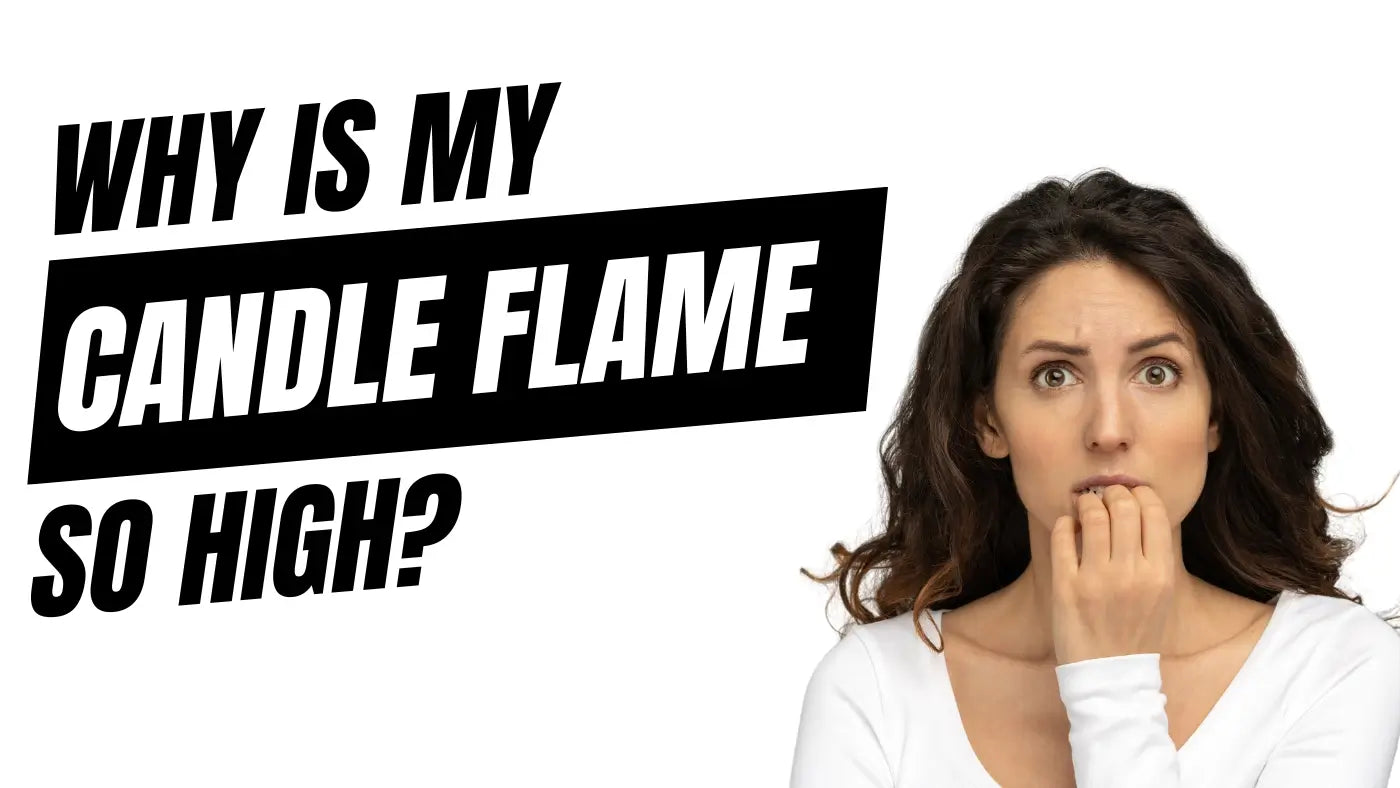- Understand the reasons behind a high candle flame.
- Identify the signs of a too hot flame, such as erratic size or excessive flickering.
- Implement solutions like trimming the wick to control flame height.
- Adjust wax absorption to regulate the burn.
- Practice safe candle usage for a longer-lasting, enjoyable experience.
- Regularly monitor the candle flame for changes and adjust accordingly.
- Remember that a healthy candle flame is steady, calm, and doesn't produce sooty smoke.
Candle Flame Too High? Let's Figure Out Why, And Fix It
Candles have been a source of light, warmth, and tranquility for thousands of years. Their gentle glow can transform any space into a serene sanctuary.
However, if you've ever noticed your candle flame burning higher than usual, you might be left wondering "why is my candle flame so high?"
A high flame can be more than just a visual spectacle; it can indicate underlying issues with your candle and affect its longevity.
This article delves into the causes of high candle flames, the role of the wick and wax in influencing the flame height, and how to fix it for a safer and more efficient burn.
Let's illuminate this further.
What Causes a High Candle Flame?
When you light a candle, the heat of the flame melts the wax near the wick. This liquid wax is drawn up into the wick where the heat of the flame evaporates the liquid wax, causing it to react with the oxygen in the air to create heat, light, water vapor and carbon dioxide.
A high candle flame can be caused by various factors, including the length of the wick, the type of wax used, and the external environment.

The Role of the Wick in a Too Big Flame
The wick plays an integral role in determining the height of your candle flame. When a candle is lit, the wick absorbs the melted wax and pulls it upwards towards the flame. This process, known as capillary action, fuels the flame and keeps the candle burning.
However, if the wick is too long, it can cause the flame to become too high. This is because a longer wick allows more melted wax to be drawn up, which results in a larger flame. Conversely, a shorter wick limits the amount of wax that can be absorbed, resulting in a smaller flame.
In addition, the material of the wick can also impact the flame size. Cotton wicks are most common and provide a steady burn, but other materials like wood or hemp can produce different flame heights and burn times due to their varying absorption rates.
The Impact of Candle Wax on Flame Height
The type of wax used in the candle can also significantly affect the flame's height. Different types of wax have different melting points, which can influence how quickly the wax is drawn up the wick and consequently, the size of the flame.
For instance, paraffin wax has a lower melting point than beeswax, so a candle made with paraffin wax may produce a higher flame as the wax can be absorbed more quickly. On the other hand, beeswax candles may have a smaller flame as the wax is denser and melts slower.
Furthermore, the quality of the wax can also play a role. Wax that contains impurities or additives might not burn as cleanly or evenly, potentially leading to an irregular flame height.
Understanding these factors can help you manage and maintain your candle effectively, ensuring a safer and more enjoyable candle burning experience.

How to Fix a High Candle Flame?
A high candle flame can be visually arresting, but it's not necessarily the best for your candle's lifespan or safety. A flame that's too high can cause the candle to burn too quickly, depleting the wax and shortening the life of your candle. Moreover, a high flame can also increase the risk of accidental fires. But worry not, as there are ways to manage and fix a high candle flame.
Steps to Trim a Long Wick
One of the most effective ways to control the size of your candle flame is by trimming the wick. Here's a simple step-by-step guide on how you can do this:
-
Wait for the Candle to Cool: Before you begin, ensure that the candle has cooled down completely. This is important as handling a hot candle can lead to burns.
-
Find the Right Length: Ideally, the wick should be around 1/4 inch long. This length is generally considered safe and offers a steady, healthy flame.
-
Trim the Wick: Using a pair of sharp scissors or a specialized wick trimmer, carefully cut the wick at the desired length. Be sure to remove any debris left on the surface of the candle.
-
Light Your Candle: After trimming, light your candle and observe the flame. If it's still too high, you might need to trim a bit more.
Remember, trimming the wick not only helps control the flame size but also promotes an even burn, preventing tunneling and helping your candle last longer.

Signs Your Candle Flame Might Be Too Hot
Identifying a high candle flame isn't always as simple as spotting a tall flame. Sometimes, the signs are more subtle but equally important to notice for the safety and longevity of your candle. Here are some common indicators that your candle flame might be burning too hot:
Erratic Flame Size: An Indicator of Excessive Heat
An unusually large or erratic flame size can be a clear sign that your candle is burning too hot. When the flame appears tall or dances wildly, it's often because the wick is drawing up wax at a faster rate than it can be burned off. This not only leads to a larger flame but also causes the wax to melt faster than it should, which can significantly shorten the lifespan of your candle.
Another sign of excessive candle temperature is a glowing or discolored wick. When a wick burns too hot, it can start to glow or change color, indicating that it's consuming more fuel than necessary.
Flickering Flames and What They Mean
A flickering flame can also be indicative of a candle burning too hot. While it's normal for a candle flame to flicker slightly, a wildly flickering flame can suggest that the candle is receiving too much oxygen, causing it to burn hotter and more erratically.
In addition, if you notice sooty smoke coming from your candle, it could mean that the flame is too hot. A properly burning candle should produce a clean, smokeless flame. If it's emitting black smoke or leaving soot marks on the candle container or nearby surfaces, it's a sign that the candle is burning too hot.
If you notice any of these signs, it's essential to address them promptly to prevent potential fire hazards and ensure a longer, more enjoyable candle burning experience.
Wrapping Up: Ensuring a Safe and Enjoyable Candle Experience
Candles bring a unique ambiance to any space, filling it with warmth, light, and often a soothing scent. However, understanding the behavior of your candle flame is crucial to maintaining not just the candle's longevity but also the safety of your surroundings. By paying attention to signs of a high or hot flame, such as erratic flame size or flickering, and implementing solutions like wick trimming or adjusting the wax absorption, you can ensure a controlled burn.
Remember, a healthy candle flame is steady, calm, and doesn't produce sooty smoke. With these tips in mind, you can create a safer, longer-lasting, and more enjoyable candle burning experience.
Whether you're a candle-making enthusiast or simply someone who enjoys their gentle glow, understanding and controlling your candle flame can significantly enhance your experience. Happy burning!
If you found that helpful, try our Candle Lovers Ultimate Guide!


